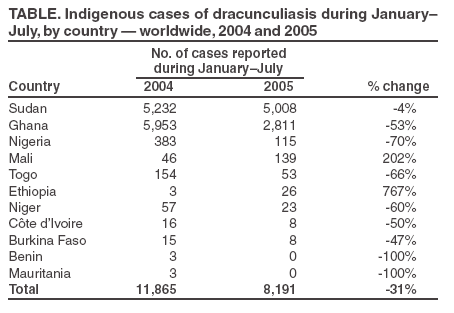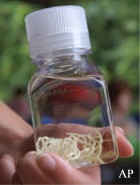Centers for Disease Control and Prevention
Also read: DRACUNCULIASIS ERADICATION: THE FINAL INCH
DONALD R. HOPKINS,* ERNESTO RUIZ-TIBEN, PHILIP DOWNS, P. CRAIG WITHERS, JR., AND JAMES H. MAGUIRE
The Carter Center, Atlanta, Georgia; Division of Parasitic Diseases, National Center for Infectious Diseases, Centers for Disease Control and Prevention, Atlanta, Georgia.
In 1986, an estimated 3.5 million cases of dracunculiasis occurred in 20 countries, and 120 million persons were at risk for the disease (1). That year, the World Health Assembly adopted a resolution calling for the eradication of dracunculiasis, also known as Guinea worm disease (2). This report describes the status of the global dracunculiasis eradication program as of July 2005 (3,4), indicating that, during January--July 2005, a total of 8,191 indigenous cases of dracunculiasis were reported from nine countries, with at least 150 million persons at risk. Despite the substantial reductions in dracunculiasis cases since 1986, eradication of dracunculiasis will require international commitment and ongoing surveillance and intensified interventions at national, state, and local levels.
At the end of 2004, Asia was free from dracunculiasis. The remaining countries where dracunculiasis was endemic, all in Africa, had reported 50% reductions in the number of cases from 2003 to 2004 (from 32,193 to 16,026), and 11 (Benin, Cameroon, Central African Republic, Chad, India, Kenya, Mauritania, Pakistan, Senegal, Uganda, and Yemen) of the original 20 countries with endemic disease had interrupted transmission. Uganda reported zero cases for an entire calendar year for the first time in 2004. Moreover, Benin and Mauritania reported zero indigenous cases for 16 and 13 consecutive months, respectively, as of July 2005. The overall number of villages with endemic disease decreased 33%, from 4,659 in 2003 to 3,109 in 2004 (compared with 23,735 villages in 1993). During January--July 2005, the number of indigenous cases worldwide decreased 31%, from 11,865 to 8,191, compared with the same period for 2004 (Table), and the number of cases exported from one country to another decreased 65%, from 69 to 24.
Ghana and Sudan have reported 95% of the world's cases so far in 2005. Ghana reported slightly more cases than Sudan in 2004 (7,275 versus 7,266, respectively), but Sudan has reported more cases than Ghana in 2005 (5,008 versus 2,811). Ghana reduced its reported cases by 53% during the first half of 2005, compared with a reduction of 12% from 2003 to 2004. Ghana's Nkwanta District, which was the district with the highest endemic disease in the country in 2004 (reporting 1,266 [17%] of all cases in Ghana), reduced its cases of dracunculiasis by 88% (from 1,199 to 144) from January--July 2004 to January--July 2005.
Sudan reported the last indigenous cases in its northern states in 2001. From 2003 to 2004, reported cases in the disease-endemic southern states declined by 67% (from 20,299 to 7,266), with respective reporting rates of 70% and 65%, despite the civil war in Sudan, which formally ended in January 2005. The uncertainties and continued lack of security in certain areas have delayed reporting of cases and implementation of interventions against the disease in 2005 after the peace agreement in Sudan.
Nigeria reported 495 cases in 2004 and has reduced its cases by an additional 70% in 2005. The remaining disease-endemic areas of Mali and Niger, where dracunculiasis primarily affects the nomadic Tuareg populations, were accessed later than other areas because of political insecurity. An infestation of locusts in 2004 and drought in 2005 have caused additional migrations in Niger in 2005. Drilling of new borehole wells to provide safe drinking water in 14, 12, and 14 villages of Mali, Niger, and Togo, respectively, is under way; four of these wells are already functioning in Mali. By using containment centers to voluntarily isolate a substantial share of its cases, Togo reduced its indigenous cases by 63% from 2003 to 2004 and by another 66% in 2005, despite a substantial number of cases imported from neighboring Ghana in 2004.
With 40 indigenous cases in 2004 and a 47% reduction in cases in 2005, Burkina Faso is approaching interruption of transmission of dracunculiasis. Côte d'Ivoire reported an outbreak of eight cases in a village in the rebel-held area of the country; those cases were not reported to the program in time to meet a strict criterion to enable case containment (i.e., detection within 24 hours of emergence of the worm) and thus prevent transmission.
Reported by: The Carter Center, Atlanta, Georgia; World Health Organization Collaborating Center for Research, Training, and Eradication of Dracunculiasis; Div of Parasitic Diseases, National Center for Infectious Diseases, CDC.
Editorial Note:
Dracunculiasis is a parasitic infection caused by Dracunculus medinensis. Persons become infected by drinking water from ponds contaminated by copepods (water fleas) that contain immature forms of the parasite. One year later, adult worms approximately 1 meter (40 inches) in length emerge through skin lesions, usually on the lower limbs, which frequently develop severe secondary bacterial infections. No effective treatment or vaccine for the disease exists, and infected persons do not become immune to future infections by the parasite. However, dracunculiasis can be prevented by 1) filtering drinking water through a finely woven cloth, 2) treating contaminated water with the larvicide ABATE® (temephos) (BASF, Ludwigshafen, Germany), 3) providing clean water from borehole or hand-dug wells (5), and 4) educating persons to avoid entering water sources when Guinea worms are emerging from their bodies.
Momentum toward eradication of dracunculiasis is accelerating, with substantial reductions in cases in 2004 and through July 2005. The reduction in dracunculiasis cases observed during 2005 in Nkwanta District of Ghana demonstrates what can be achieved when a program focuses attention on case detection and containment and on implementation of interventions against disease transmission, including supervision of program staff. Ensuring adequate surveillance in areas of Ghana that no longer have endemic disease is also critical to preventing reintroduction of the disease.
The reduction in cases exported from southern Sudan to the northern states and to neighboring countries indicates that the recent decline in cases in Sudan is real. The reductions in cases within southern Sudan are a net result of underreporting (e.g., poor surveillance in some areas with endemic disease), overreporting (e.g., poor surveillance resulting from failure to adhere to the case definition or reporting of fictitious cases), inaccessibility to disease-endemic areas with ongoing civil conflicts, access to newly secure areas, and the effects of interventions by Sudan's Guinea Worm Eradication Program. A challenge grant provided by the Bill & Melinda Gates Foundation in support of the dracunculiasis eradication program and the recent peace agreement should remove major obstacles to eradication in southern Sudan.
The increased rate of reduction of cases, the reduction in cases exported to other countries during 2004--2005, and the peace agreement in Sudan indicate that the final phase of the global dracunculiasis eradication program might be executed without further delays and be concluded by the target date of 2009 (6). Recent development of a reliable means to distinguish D. medinensis from other species of Dracunculus (i.e., by sequence analysis of the 18S RNA) (7) will facilitate investigation of sporadic cases at this stage by eliminating false positives in areas now free from dracunculiasis transmission and in areas reporting few cases of disease. Successful completion of the global campaign will require attention to the quality of surveillance, supervision of national eradication program staff, and implementation of interventions in each of the remaining disease-endemic countries, especially Ghana and Sudan.
References

Use of trade names and commercial sources is for identification only and does not imply endorsement by the U.S. Department of Health and Human Services.
References to non-CDC sites on the Internet are provided as a service to MMWR readers and do not constitute or imply endorsement of these organizations or their programs by CDC or the U.S. Department of Health and Human Services. CDC is not responsible for the content of pages found at these sites. URL addresses listed in MMWR were current as of the date of publication
Disclaimer - All MMWR HTML versions of articles are electronic conversions from ASCII text into HTML. This conversion may have resulted in character translation or format errors in the HTML version. Users should not rely on this HTML document, but are referred to the electronic PDF version and/or the original MMWR paper copy for the official text, figures, and tables. An original paper copy of this issue can be obtained from the Superintendent of Documents, U.S. Government Printing Office (GPO), Washington, DC 20402-9371; telephone: (202) 512-1800. Contact GPO for current prices.
**Questions or messages regarding errors in formatting should be addressed to [email protected]
Date last reviewed: 10/26/2005
![]()


Dracunculus medinensis worms are displayed in Atlanta, Georgia, where volunteers assembled 30,000 medical kits for The Carter Center in 2004 to help eradicate dracunculiasis (Guinea worm disease). This week's MMWR includes a report on the progress toward eradication.